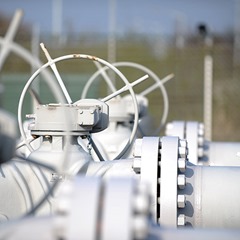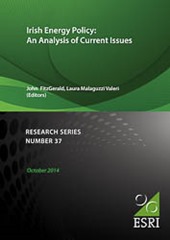Energy’s key challenges
 Michael McKernan analyses the latest energy report from the ESRI which outlines the strategic challenges facing the sector in coming years, including the need to regulate effectively and reduce uncertainty.
Michael McKernan analyses the latest energy report from the ESRI which outlines the strategic challenges facing the sector in coming years, including the need to regulate effectively and reduce uncertainty.
The Economic and Social Research Institute (ESRI) recently published a report which outlines some of the key issues energy policy-makers in Ireland are likely to face in the immediate years ahead. ‘Irish Energy Policy: An Analysis of Current Issues’ – edited by Professor John FitzGerald and Laura Malaguzzi Valeri – examines a range of energy policy issues, both national and international, likely to have a significant impact on the Irish energy sector over the coming decade. The timing of the report is also interesting given that it has landed at a point in time where the Government is assessing responses to its energy green paper published earlier this year – in advance of publishing an energy white paper in the spring of next year.
Interestingly, the report argues that together with the three traditional main considerations in energy policy – security of supply, competitive prices and environmental impact – there is a fourth consideration around ‘distributive effects’ of energy policy. This is where policy leads to significant transfers between countries or within a country between producers and suppliers and their customers.
Regulation
Overall, the main theme of the ESRI report is that there are several key policy issues where the policy-makers at national and international level need to get the detailed regulation absolutely fine-tuned in order to avoid unintended redistributive effects. Such distributive effects could cause Ireland as a whole and Irish consumers individually to experience very substantially increased energy costs in the years ahead. The report argues that certain actions should logically follow to minimise this risk.
In the report itself, the ESRI is critical of the proposed EU model for developing the European single market for electricity. The current EU proposals, which are aimed at further enhancing the opportunity to trade electricity across all member states, will involve a major investment in technology and systems in every jurisdiction. The ESRI study claims that there is a risk that the new regime could lead to “significantly higher” prices for Irish consumers and that the costs of introducing and operating the new system would, at least in the case of Ireland, outweigh the benefits. In fact, the action the report recommends is that the EU should hold back on the proposed introduction of the new regime and work to devise a much lower cost model.
The ESRI also warns of the danger of having a higher than necessary cost attaching to the provision of expensive but much needed energy infrastructure. Referencing essential infrastructure such as the North/South electricity interconnector, further electrical interconnection with mainland Europe and Corrib gas field production, the report points to the costs of uncertainty (including public opposition and permitting obstacles) around these key projects. This uncertainty leads to a higher cost of capital for the developers and ultimately higher costs passed through to consumers. Policy-makers should therefore, in order to minimise risk and the cost of capital, try to reduce any unnecessary uncertainty around such major infrastructural investments, particularly in relation to the planning process and the overall regulatory environment.
Reduce uncertainty
Similarly, the ESRI report highlights difficulties and uncertainties around the outworking of international and EU policy on tackling climate change. It points to the fact that the European emissions trading system has not worked well to date and that the allocations of quantitative targets to individual member states can over time lead to major transfers between member states in the later years of a target period. If Ireland, for example, has an unrealistic target for emissions reductions, compliance could require actions that are much more expensive than for other EU countries, implying substantial future transfers between Ireland and the rest of the EU.
 Although the ESRI acknowledges the need for some EU-wide pricing mechanism for emissions reduction, these need to take account of possible adverse distributive effects in the later years of a programme. Also, where quotas are to be used as an EU policy instrument they should, ideally, be auctioned rather than allocated to ensure that there are no ‘windfall’ gains for producers.
Although the ESRI acknowledges the need for some EU-wide pricing mechanism for emissions reduction, these need to take account of possible adverse distributive effects in the later years of a programme. Also, where quotas are to be used as an EU policy instrument they should, ideally, be auctioned rather than allocated to ensure that there are no ‘windfall’ gains for producers.
Also, it is noted that Ireland has an exposure to uncertainty around future UK energy policy. It remains a distinct possibility that the UK could leave the European Union and thereby find itself no longer bound by EU energy market rules. Given the level of interconnectivity and energy trading between Britain and Ireland, such a development could have a profound impact on Irish energy consumers.
There are also major lessons to be learned by Europe and Ireland from past experience in developing new energy efficient and renewable energy technologies. In particular, the example of onshore wind energy development is cited where, fortunately for energy consumers, large scale deployment did not take place until costs had fallen substantially. Therefore, the report argues, large scale deployment, for example of offshore wind and wave generation, should await the major fall in costs that comes when the technology has been fully proven and moved beyond the research and development phase. This is also very important for the design of incentivisation and support schemes for new technologies. Often, in the past, subsidies have been set at too high a level and then ‘grandfathered’ for long periods during which time actual costs fell substantially. This approach to subsidy was highly inefficient and lumbered consumers with an unnecessary long-term cost burden: in economic terms, effectively a redistribution or transfer from consumers to producers.
 Despite focusing on the distributional aspect of future developments in Ireland’s energy framework the ESRI report is critical of the Government’s view that the energy sector should be capable of generating considerable additional employment and of driving the economy forward. Professor FitzGerald said: “Job creation in the energy sector is not, and should not be, the objective of energy policy. Instead the objective should be to deliver a secure and environmentally friendly energy supply to Irish consumers at minimum cost.”
Despite focusing on the distributional aspect of future developments in Ireland’s energy framework the ESRI report is critical of the Government’s view that the energy sector should be capable of generating considerable additional employment and of driving the economy forward. Professor FitzGerald said: “Job creation in the energy sector is not, and should not be, the objective of energy policy. Instead the objective should be to deliver a secure and environmentally friendly energy supply to Irish consumers at minimum cost.”
Time will tell how much the ESRI report will influence government energy policy and the final shape of the forthcoming white paper. However, there is little doubt that the ESRI, while not in every instance providing a ready solution to each problem it has identified in the report, has made an interesting and possibly very significant contribution to the energy policy debate in Ireland.





